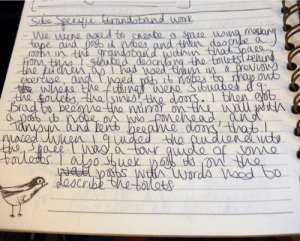Walking around the perimeter of the Grandstand in Lincoln, I stoop down under a tree to find an old, empty and slightly grubby tube of toothpaste. Why, you ask, am I spending my time rooting around under bushes to find used toiletries? Well this is site specific performance, and if a urinal can be art then so can a bottle of Colegate’s finest.
I am joking, of course, but my find did spark rather a lot of thinking once I had returned home from our morning exploring the Grandstand, its history and its architecture. A thriving racecourse before its demise in 1965, the space is steeped in history, and looking out across the green fields surrounding the building I can’t help but imagine hoards of men and women, clutching betting slips and intently watching the horses thunder across the track.
A road goes right through what would have been the track now, and while seeing many cars go past during the three hours we were at the site didn’t break the sense of nostalgia and history, the toothpaste certainly did. Its presence within the grounds of the Grandstand threw me off completely, as I was looking at such a representation of the modern day when the objects which used to litter the site would have been discarded betting slips and cigarette stubs.
The toothpaste was found as a result of a task we were set to find objects on the site of the Grandstand. While I wasn’t surprised to find it, it also made me think very clearly about the changes this place has gone through, and the changes many other places have to endure, as communities place pressure on these sites to be utilised as community centres or golf courses or other things our growing populations need.
The Grandstand is still a wonderful site, and I can’t wait to get to know it more as we get further through the process- but knowing that among the users of the golf course and visitors to the community centre there are also people who are using the space as a litter box for their 21st Century toothpaste tubes, makes me a little sad and put out.







